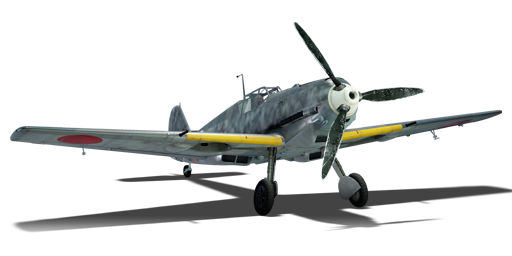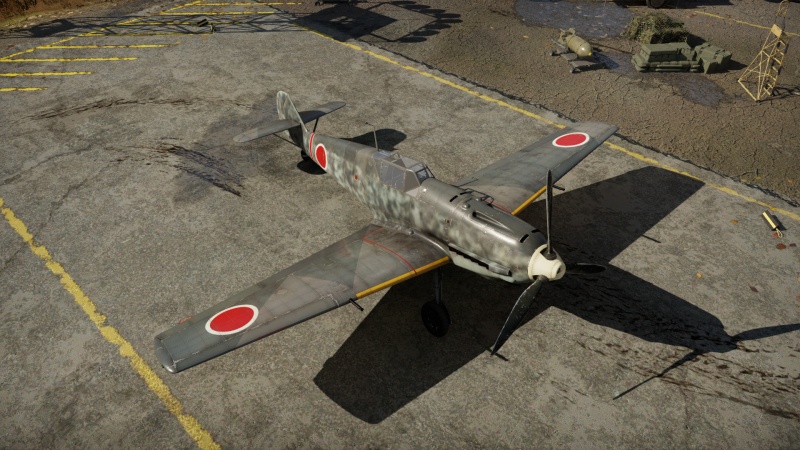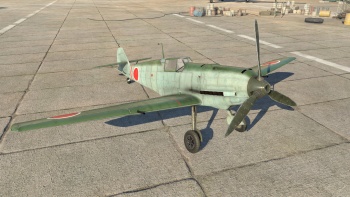Difference between revisions of "Bf 109 E-7 (Japan)"
m (→External links) |
|||
| Line 230: | Line 230: | ||
== External links == | == External links == | ||
| − | ''Paste links to sources and external resources, such as:'' | + | <!--''Paste links to sources and external resources, such as:'' |
* ''topic on the official game forum;'' | * ''topic on the official game forum;'' | ||
* ''encyclopedia page on the aircraft;'' | * ''encyclopedia page on the aircraft;'' | ||
| − | * ''other literature.'' | + | * ''other literature.''--> |
| + | |||
| + | * [https://forum.warthunder.com/index.php?/topic/287348-messerschmitt-bf-109-e-7u2/ Official data sheet - more details about the performance] | ||
{{AirManufacturer BFW}} | {{AirManufacturer BFW}} | ||
{{Japan fighters}} | {{Japan fighters}} | ||
{{Japan premium aircraft}} | {{Japan premium aircraft}} | ||
Revision as of 19:14, 25 January 2021
| This page is about the premium Japanese fighter Bf 109 E-7 (Japan). For other uses, see Bf 109 (Family). |
Contents
Description
The ▅Bf 109 E-7 is a premium rank II Japanese fighter with a battle rating of 3.0 (AB/RB) and 2.7 (SB). It has been in the game since the start of the Open Beta Test prior to Update 1.29 as the Bf 109 E-3; it was renamed to the Bf 109 E-7 in Update 1.65 "Way of the Samurai".
While essentially the same plane as the E-3, the E-7 overcomes the inadequate MgFF for MgFF/M, featuring the fantastic minengeschoße. With two wing-mounted MG FF/Ms with 60 rounds each, the plane has an even more deadly punch, attributed solely to the new installed HE-20 mm shell. Fighting in the E-7/U2 is essentially the same as with all E-frame 109s.
Remaining a great energy fighter versus its historical opposition, the E-7 is somewhat troubled by the fact that it often faces mid-to-later warplanes such as the P-47D. To engage these, make sure you have a clear energy advantage or, if attacked, fly defensively and attempt to bleed the enemies speed while pulling him down. The Bf 109 E-7 is often not regarded as a good turner, a reputation coming out of the fact that its main rival, the Spitfire, simply did it better. However, especially with combat flaps, the E-7 is a respectable turner able to out turn most planes that outperform it. Keep in mind though that one of the changes from E-3 to E-7 increased the frame's weight. Flat turning should only be reserved for extreme situations.
General info
Flight performance
| Characteristics | Max Speed (km/h at 5,000 m) |
Max altitude (metres) |
Turn time (seconds) |
Rate of climb (metres/second) |
Take-off run (metres) | |||
|---|---|---|---|---|---|---|---|---|
| AB | RB | AB | RB | AB | RB | |||
| Stock | 544 | 532 | 11000 | 21.3 | 21.8 | 14.0 | 14.0 | 376 |
| Upgraded | 594 | 570 | 18.7 | 20.0 | 26.5 | 17.8 | ||
Details
| Features | ||||
|---|---|---|---|---|
| Combat flaps | Take-off flaps | Landing flaps | Air brakes | Arrestor gear |
| ✓ | ✓ | ✓ | X | X |
| Limits | ||||||
|---|---|---|---|---|---|---|
| Wings (km/h) | Gear (km/h) | Flaps (km/h) | Max Static G | |||
| Combat | Take-off | Landing | + | - | ||
| 790 | 320 | 500 | 450 | 280 | ~12 | ~3 |
| Optimal velocities (km/h) | |||
|---|---|---|---|
| Ailerons | Rudder | Elevators | Radiator |
| < 370 | < 370 | < 420 | > 250 |
| Compressor (RB/SB) | ||
|---|---|---|
| Setting 1 | ||
| Optimal altitude | 100% Engine power | WEP Engine power |
| 4,800 m | 905 hp | 1,086 hp |
Survivability and armour
- 10 mm Steel plates behind the pilot.
Modifications and economy
Armaments
Offensive armament
The Bf 109 E-7 (Japan) is armed with:
- 2 x 20 mm MG FF/M cannons, wing-mounted (60 rpg = 120 total)
- 2 x 7.92 mm MG 17 machine guns, nose-mounted (1,000 rpg = 2,000 total)
Usage in battles
Just as the with the E-1, new players should adopt a hit and run tactic with the Bf 109s. While often called Boom & Zoom aircraft, the 109s are not dedicated Boom & Zoomers and many other aircraft such as the FW 190 do it much better. While it is true that a pure Boom and Zooming approach can be used in the 109s, limiting oneself to this undermines one's plane efficiency enormously. That said, the 109s does build up speed fast in a dive and they have a respectable zoom climb that ends in a strong sustained climb at ~270 km/h [optimal climbing speed 260 km/h - 280 km/h]. Doing so will often see the player with the maximum speed or altitude advantage he can have over his chosen target. A straight-up bounce, with a short extension from the target and a slowly increasing climb leading into an Immelmann, tends to work best for rookie pilots. Remember to check your six and surrounding during the climb and just before diving back on your target.
With mounting experience on the side of the player, the energy fighting abilities of the Bf 109 E-7 come to the forefront. Fluid and speedy transitions between altitude and speed, together with well-timed uses of flaps, throttle and manoeuvres enable the Emil to quickly change the nature of the engagement in its favour.
When firing at enemies, be aware that your 20 mm cannons only hold a 60 round drum magazine each. They empty quick and many a new pilot has seen himself on pitiful low ammunition even after his first attack run. Once you emptied your cannons, the E-7 will be hard-pressed to secure a kill. In your own interest, do not waste your cannons on ground targets and when firing at planes, fire, in short, controlled and well-aimed bursts. Luckily, the E-7 holds 1,000 rounds in each of its two MG 17s. Use these if you are inclined to spray and pray or are about to engage ground targets.
Manual Engine Control
| MEC elements | ||||||
|---|---|---|---|---|---|---|
| Mixer | Pitch | Radiator | Supercharger | Turbocharger | ||
| Oil | Water | Type | ||||
| Controllable | Not controllable | Not controllable | Not controllable | Separate | Not controllable | Not controllable |
Pros and cons
Pros:
- Good acceleration
- Good rate of climb
- Good continuous turn rate
- Good roll rate
- Good sustained turn rate
- Good amount of Light Machine Gun ammo
- Can endure negative Gs without the engine dying (realistic and simulator battles)
- Better cockpit visibility than Bf 109F's
Cons:
- Less than average instantaneous turn rate
- Control stiffening above 400 IAS (km/h)
- Low cannon ammo
- Weak low-velocity cannons compared to others; Hispano, Mg 151
- Relatively poor durability
History
Although Imported, Japan decided to not pursue a license agreement with Germany over the Bf 109E. The Emil, (Nicknamed Mike) would stay in Japan until the end of the war.
In-game description
"Messerschmitt Bf 109E ""Emil"" single-engine front-line fighter
In 1941, a Bf 109E prototype fighter was sold to Japan as a part of the German-Japanese military technical cooperation. The aircraft was delivered to the Land of the Rising Sun without armament for flight tests. Japanese Hinomaru markings and a tail number of ""1"" were applied to the fighter, and then the machine underwent a complete cycle of flight tests at the Kawasaki Company's factory airfield. Comparative tests of the Bf 109E were also performed, with Japanese army fighters involved, such as the Nakajima Ki-43 Type 1 Hayabusa, the Nakajima Ki-44 Type 2 Shoki, and the Kawasaki Ki-61 Type 3 Hien prototype. The aircraft was piloted not only by the Japanese but also by a German test pilot named Willy Stor.
The Japanese were most of all interested in the Messerschmitt's DB 601 engine, whose licensed production was being mastered by the Japanese industry at the same time and which was to be mounted on the Ki-61 Hien, the newest fighter being developed in Japan. That is why the Bf 109E itself, as well as any prospects of its licensed manufacture, aroused minimal interest among Japanese specialists."
Media
See also
- Aircraft of comparable role, configuration and era
- Mitsubishi A6M
- Bell P-39 Airacobra
- Curtiss P-36
- Curtiss P-40
- Dewoitine D.520
- Fiat G.55
- Focke-Wulf Fw 190
- Grumman F4F Wildcat
- Grumman F6F Hellcat
- Hawker Hurricane
- Heinkel He 112
- IAR-81
- Kawasaki Ki-61
- Lavochkin LaGG-3
- Macchi C.202
- Macchi C.205
- Mikoyan-Gurevich MiG-3
- Morane-Saulnier MS.406
- Nakajima Ki-43
- North American P-51 Mustang
- Polikarpov I-16
- Supermarine Spitfire
- Yakovlev Yak-1
- Yakovlev Yak-9
External links
| Japan fighters | |
|---|---|
| Navy | |
| Carrier-based fighter | |
| A5M | A5M4 · Hagiri's A5M4 |
| A6M | A6M2 mod. 11 · A6M2 · A6M3 · A6M3 mod. 22 · A6M3 mod. 22Ko · A6M5 · A6M5 Ko · A6M5 otsu · A6M5 Hei · A6M6c |
| A7He | A7He1* |
| A7M | A7M1 (NK9H) · A7M2 |
| Land-based Fighter | |
| J2M | J2M2 · J2M3 · J2M4 Kai · J2M5 · J2M5 (30 mm) |
| J6K | J6K1 |
| J7W | J7W1 |
| N1K-J | N1K1-Ja · N1K2-J · N1K2-Ja |
| Fighter seaplane | |
| N1K | N1K1 |
| A6M-N | A6M2-N |
| Army | |
| Ki-10 | Ki-10-I · Ki-10-I C · Ki-10-II · Ki-10-II C |
| Ki-27 | Ki-27 otsu · Ki-27 otsu Tachiarai |
| Ki-43 | Ki-43-I · Ki-43-II · Ki-43-III otsu |
| Ki-44 | Ki-44-I · Ki-44-I 34 · Ki-44-II otsu · Ki-44-II hei |
| Ki-61 | Ki-61-I ko · Ki-61-I otsu · Ki-61-I hei · Tada's Ki-61-I hei · Ki-61-I tei · Ki-61-II Otsu Kai |
| Ki-84 | Ki-84 ko · Ki-84 otsu · Ki-84 hei |
| Ki-87 | Ki-87 |
| Ki-94 | Ki-94-II |
| Ki-100 | Ki-100 · Ki-100-II |
| Other countries | ▅F4U-1A · ▅P-51C-11-NT · ▅Bf 109 E-7 · ▅Fw 190 A-5 |
| *Imported designation of the He 112 (A6M was in development - A7M would take A7 designation after the cancelation of the A7He) | |
| Japan premium aircraft | |
|---|---|
| Fighters | Hagiri's A5M4 · A7He1 · Ki-27 otsu Tachiarai |
| Ki-44-II otsu · ▅Bf 109 E-7 · ▅F4U-1A · Ki-100-II · Ki-44-I 34 | |
| ▅Fw 190 A-5 · A7M1 (NK9H) · Tada's Ki-61-I hei · ▅P-51C-11-NT | |
| J2M4 Kai · A6M5 Ko · A6M6c · J2M5 · Ki-87 · J6K1 | |
| Twin-engine fighters | Ki-96 |
| Jet fighters | F-86F-40 JASDF▅ · T-2 Early · F-4EJ ADTW |
| Strike aircraft | ▄AV-8S |
| Bombers | Ki-21-I hei · Ki-48-II otsu · H8K3 · B7A2 (Homare 23) · ▅B-17E |






